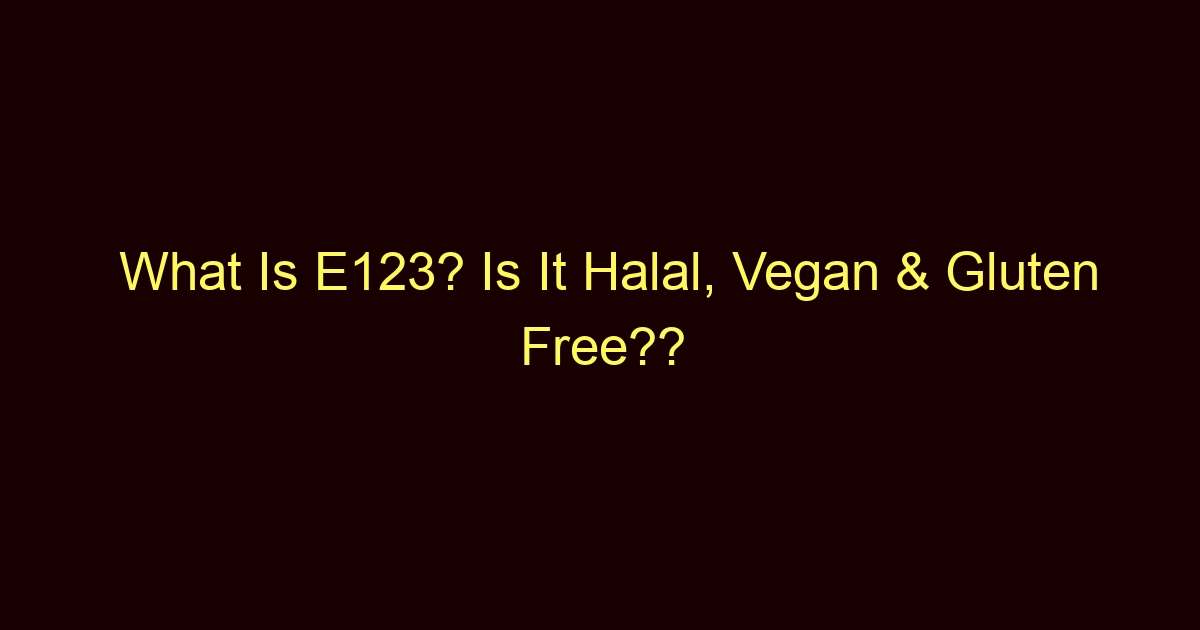The food industry can sometimes feel like a labyrinth, especially with the various ingredients and additives used in our everyday consumables. Each one has its own identity, often expressed as a mysterious ‘E’ number. Today, we are focusing on one such compound: E123, otherwise known as Amaranth.
What is E123?
E123, commonly referred to as Amaranth, is a synthetic food colorant with a dark red to purple hue. It’s named after the Amaranth grain plant, which produces a similar vibrant red color, although the dye itself is not derived from this plant. E123 was extensively used in the food industry to provide an appealing look to various food and drink products such as cake mixes, fruit-flavored fillings, and certain alcoholic beverages.
E123 garnered attention due to its unique ability to retain its color at higher temperatures and varying pH levels. Unlike some food colorants that fade when cooked or baked, E123 keeps its vibrant color, making it a favored choice for many food manufacturers.
However, it’s worth noting that despite its widespread usage in the past, E123 has been the subject of various health concerns, leading to its ban in several countries, including the United States and many European Union member states. Concerns revolve around potential allergic reactions and carcinogenic effects, although concrete evidence remains limited.
How is E123 Made?
The process of manufacturing E123 or Amaranth involves a series of chemical reactions. Initially, nitrobenzene is converted into aniline using a reducing agent. This aniline is then diazotized and coupled with 2-naphthol-6-sulphonic acid. The resulting compound is purified and isolated as a sodium salt, yielding the finished product, Amaranth.
E123 is synthetic and does not contain any natural components, despite its name being derived from the Amaranth plant. Its production process, though, is controlled under strict conditions to ensure the safety and quality of the dye.
Is E123 Halal?
Yes, E123 or Amaranth is considered Halal. It’s a synthetic dye produced through chemical reactions, not involving any haram (prohibited) substances like pork or alcohol in its production process. Thus, it is technically permissible according to Islamic dietary laws.
However, it’s important to remember that while E123 itself may be Halal, it is banned in many countries due to health concerns. This leads us to question its suitability, not just from a religious standpoint but also a health perspective.
Is E123 Vegan?
Yes, E123 or Amaranth is Vegan. Since it’s a synthetic compound and doesn’t involve any animal-derived ingredients or by-products in its production process, it’s suitable for individuals following a vegan lifestyle.
Yet, similar to the Halal standpoint, although the dye itself aligns with vegan principles, the health concerns associated with its use should be a consideration for anyone prioritizing a healthy and wholesome diet.
Is E123 Gluten Free?
Yes, E123 or Amaranth is gluten-free. This synthetic dye does not contain wheat, rye, barley, or any other gluten-containing grains. This makes it safe for individuals with celiac disease or those who prefer a gluten-free diet.
However, it’s essential to check the labels of the final food product for any potential sources of gluten, and to consider the health concerns surrounding E123.
E123: Is It Safe or Harmful?
The question of whether E123 is safe or harmful remains contentious. The safety of Amaranth as a food colorant has been the subject of debate for several years. Although it was once widely used, an increasing number of studies suggest it might have adverse health effects, which led to its ban in many countries.
The concerns around E123 mainly revolve around potential allergic reactions and its classification as a potential carcinogen. However, definitive evidence supporting its carcinogenic effects in humans remains limited.
Despite the ban in certain regions, some countries still permit the use of E123, as it’s considered safe within the prescribed usage limits. Consumers are advised to be aware of these concerns and make informed choices about their food intake.
Final Thoughts
E123 or Amaranth certainly holds a unique spot in the realm of food additives. Once a prevalent choice for imparting a vibrant red color to food products, its usage has dwindled due to health concerns and regulatory restrictions.
E123 underscores a critical aspect of food consumption: awareness. As consumers, it’s crucial to be aware of what goes into our foods and the potential effects they might have on our health. While E123 might be Halal, vegan, and gluten-free, it’s always wise to consider the broader implications on our health. And with the growing demand for natural and wholesome food products, the future of additives like E123 is indeed a topic to ponder.

